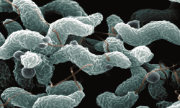Pathogen and transmission
Campylobacteriosis is a bacterial infectious disease, and is often responsible for diarrhoea. The disease is caused by bacteria of the Campylobacter genus. The pathogen is widespread. Natural reservoirs for it include wild animals (birds and rodents), livestock (poultry and cattle) and pets (dogs and cats).
Transmission to humans is generally via contaminated food such as undercooked meat (poultry in particular), untreated water or unpasteurised milk, or via direct contact with animals carrying the bacteria. In many cases transmission occurs through cross-contamination between meals ready to eat and raw contaminated food items – while preparing or storing food, for example. Human-to-human transmission is also possible, especially between children, but is rare.
Pathology
Many cases of campylobacteriosis are asymptomatic. Otherwise, the first symptoms such as diarrhoea, stomach cramps, general malaise, fever and sometimes vomiting will occur two to five days after infection. In some cases blood or mucus may be found in the runny stool. Persons affected will generally recover within one to two weeks; but if the condition is left untreated, relapses may occur.
Campylobacteriosis can lead to complications in some rare cases. These include reactive arthritis (also known as Reiter’s syndrome), meningitis or Guillain-Barré syndrome, an acute condition which causes progressive muscle weakness and sometimes paralysis.
Distribution and frequency of occurrence
Campylobacter infections occur worldwide. In both industrialised and developing countries, they are a more frequent cause of diarrhoea than even salmonella. Between 7,000 and 8,000 cases of campylobacteriosis are reported in Switzerland every year.
Prevention
Among the preventive measures for campylobacteriosis, consistent kitchen hygiene is essential for prevention, especially when preparing fresh or frozen poultry. All such meat should be thoroughly cooked through, hands should be washed regularly with soap and any possibly contaminated kitchen utensils or surfaces should be washed thoroughly with hot water and cleaning agents and then thoroughly dried. Raw milk should be boiled before consumption; and when eating “fondue chinoise”, separate plates should be used for the raw meat and the further accompaniments. The hands should also be washed after any contact with pets.


